Angkor Wat Mandir: 12th CE Largest Cambodia Hindu Temple
Angkor Wat Mandir is a temple complex in Cambodia and the largest religious monument in the world, built by the Khmer King Suryavarman II in the 12th century. It is dedicated to the Hindu god Vishnu, but was gradually transformed into a Buddhist temple towards the end of the century.
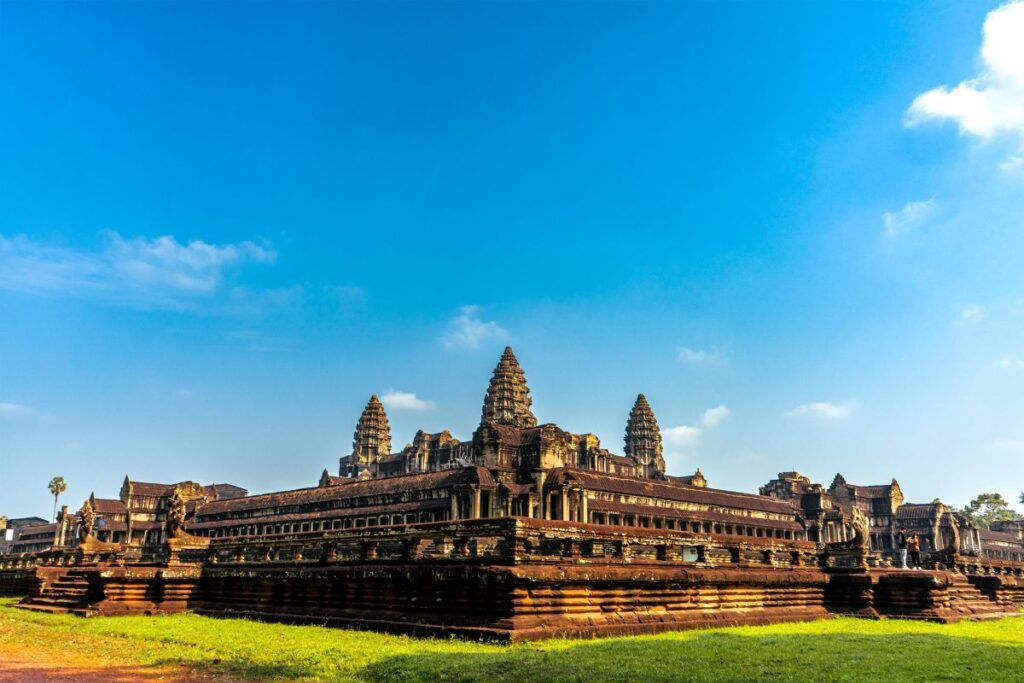
Contents
- 1 History of Angkor Wat Mandir:
- 2 Significance of Angkor Wat Mandir:
- 3 Legend of Angkor Wat Mandir:
- 4 Myths of Angkor Wat Mandir:
- 5 Architecture of Angkor Wat Mandir:
- 6 Specialty of Angkor Wat Mandir:
- 7 Why Angkor Wat was converted into a Buddhist temple:
- 8 Places to visit near Angkor Wat Mandir:
- 9 Angkor Wat Temple Construction:
- 10 FAQ:
- 10.0.1 Q: What is Angkor Wat Mandir?
- 10.0.2 Q: Where is Angkor Wat Mandir located?
- 10.0.3 Q: What is the best time to visit Angkor Wat Mandir?
- 10.0.4 Q: How do I get to Angkor Wat Mandir?
- 10.0.5 Q: What are the best things to see and do at Angkor Wat Mandir?
- 10.0.6 Q: What are some tips for visiting Angkor Wat Mandir?
- 11 How to reach Angkor Wat Mandir:
- 12 Google Maps:
History of Angkor Wat Mandir:
The construction of Angkor Wat took place over 28 years, from 1122 to 1150 CE. It is estimated that over 300,000 workers and 6,000 elephants were used in its construction. The temple complex is made up of over 1,000 buildings, including the central temple, which is surrounded by a moat and a wall.
The central temple is a five-towered structure that represents Mount Meru, the home of the gods in both Hinduism and Buddhism. Cambodia Hindu Temple is decorated with over 2,000 bas-reliefs, which depict scenes from Hindu and Buddhist mythology.
Cambodia Hindu Temple was abandoned in the 15th century, after the Khmer Empire collapsed. The temple complex was rediscovered by French explorers in the 19th century, and it has since become one of the most popular tourist destinations in Cambodia.
Angkor Wat is a UNESCO World Heritage Site and is considered to be one of the greatest architectural masterpieces of all time. It is a testament to the skill and craftsmanship of the Khmer people, and it continues to fascinate and inspire visitors from all over the world.
Explore More Temples>> Kalighat Kali Temple Kolkata
Significance of Angkor Wat Mandir:
Angkor Wat is significant for a number of reasons. First, it is a stunning example of Khmer architecture, which is characterized by its large scale, intricate carvings, and harmonious proportions. The temple is also significant for its religious significance. It was originally built as a Hindu temple dedicated to the god Vishnu, but it was converted to a Buddhist temple in the late 12th century. Angkor Wat has remained an important pilgrimage site for Buddhists ever since.
In addition to its religious significance, Angkor Wat is also significant for its historical and cultural value. It provides a glimpse into the power and wealth of the Khmer Empire, which was one of the most powerful empires in Southeast Asia during the 12th century. This place is also a testament to the skill and artistry of the Khmer people.
Here are some specific reasons why Angkor Wat is significant:
- It is the largest religious monument in the world, covering an area of over 400 acres.
- It is a masterpiece of Khmer architecture, with intricate carvings and harmonious proportions.
- It is a significant religious site for both Hindus and Buddhists.
- It provides a glimpse into the power and wealth of the Khmer Empire.
- It is a testament to the skill and artistry of the Khmer people.
- It is a UNESCO World Heritage Site and one of the most popular tourist destinations in Southeast Asia.
Explore More Temples>> Nainativu Nagapooshani Amman Temple
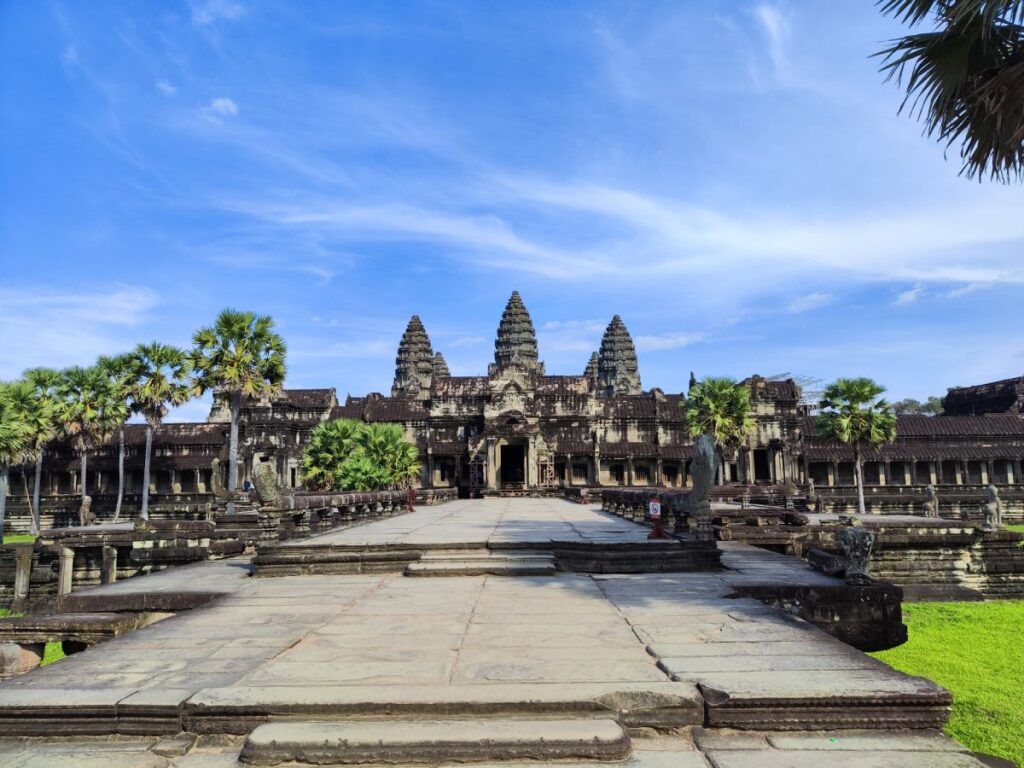
Legend of Angkor Wat Mandir:
Angkor Wat is the largest religious monument in the world, and its construction is shrouded in legend. One popular legend tells that this temple was built by the god Indra for his son, Precha Ket Mealea. According to the legend, Cambodia Hindu Temple was built in a single night by a divine architect.
Another legend tells that Angkor Wat was built by King Suryavarman II as a tomb for himself. The legend says that Suryavarman II was so powerful that he could even control the gods. He ordered the gods to build him a temple that would be the most magnificent in the world. The gods agreed, but they warned Suryavarman II that if the temple was not finished before he died, he would be trapped inside forever.
Suryavarman II’s workers worked tirelessly to build the temple, but they were unable to finish it before he died. As a result, Suryavarman II’s soul is said to be trapped inside Angkor Wat to this day.
There are many other legends about Cambodia Hindu Temple, but they all agree on one thing: This shrine is a place of great power and mystery.
One of the most famous legends about this temple is the story of the Apsaras. Apsaras are celestial nymphs in Hindu mythology. They are known for their beauty and their ability to dance. According to legend, the Apsaras were so enchanted by Angkor Wat that they came down from heaven to dance on its walls.
The Apsaras are often depicted in the bas-relief sculptures that adorn the walls of Angkor Wat. They are shown dancing, playing musical instruments, and offering flowers. The Apsaras are said to be a symbol of the beauty and divinity of Angkor Wat.
Another legend about this mandir is the story of the Naga. Nagas are serpent-like creatures in Hindu mythology. They are often depicted as having human heads. According to legend, the Nagas helped to build Angkor Wat. They carried the stones used to build the temple from the nearby mountains.
The Nagas are sometimes depicted in the bas-relief sculptures at Angkor Wat. They are shown carrying stones, pulling chariots, and even guarding the temple. The Nagas are said to be a symbol of the strength and power of Angkor Wat.
Cambodia Hindu Temple is a place of great mystery and wonder. The legends that surround it add to its allure. Whether you are a religious pilgrim or simply a curious traveler, Angkor Wat is a must-see destination.
Explore More Temples>> Naina Devi Temple Bilaspur
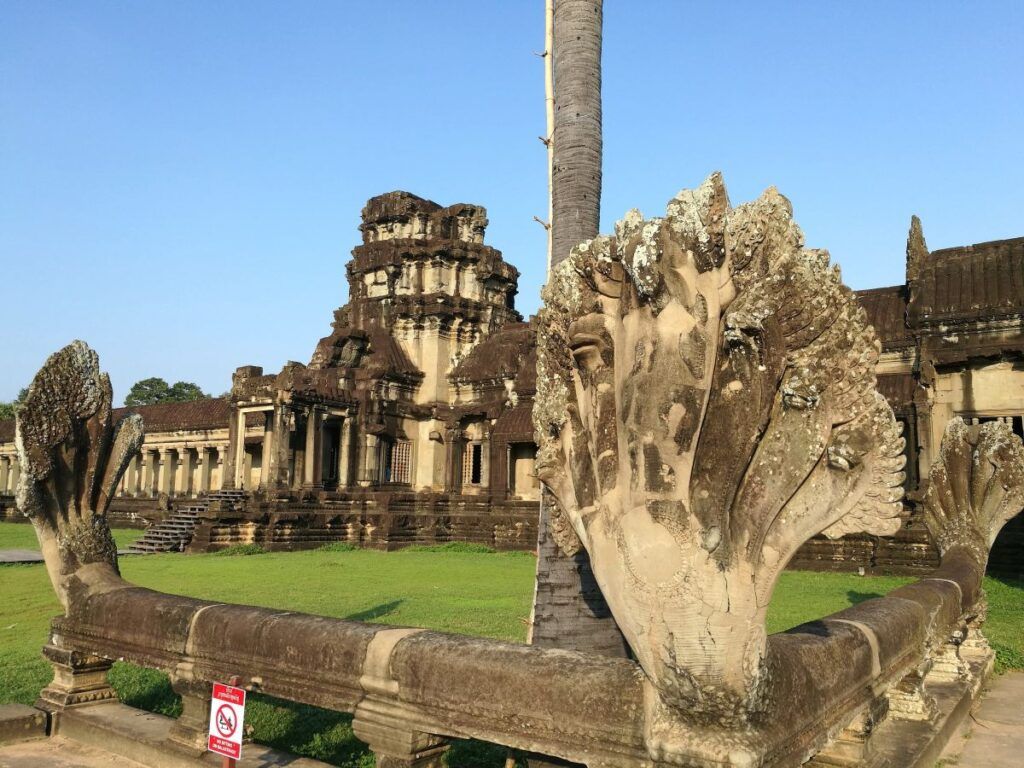
Myths of Angkor Wat Mandir:
Here are some of the myths associated with Angkor Wat Mandir:
- Angkor Wat was built in a single night. According to the 13th-century Chinese traveler Zhou Daguan, some people believed that this temple was constructed in a single night by a divine architect. This myth is likely due to the temple’s vast size and intricate design.
- Angkor Wat was built by giants. Another myth is that Angkor Wat was built by giants. This myth is likely due to the fact that Cambodia Hindu Temple was constructed with massive blocks of sandstone, weighing up to 15 tons each. It is difficult to imagine how humans could have moved such large stones without the use of modern machinery.
- Angkor Wat is a portal to another world. Some people believe that Angkor Wat is a portal to another world, or even to the afterlife. This myth is likely due to the temple’s mysterious aura and its intricate carvings, which depict scenes from Hindu and Buddhist mythology.
- Angkor Wat is cursed. Some people believe that Angkor Wat is cursed. This myth is likely due to the fact that the temple was abandoned for centuries after the Khmer Empire collapsed. During this time, Cambodia Hindu Temple was overgrown by jungle and became a home to wild animals. When the temple was rediscovered in the 19th century, it was in a state of ruin.
It is important to note that these are just myths and legends. There is no scientific evidence to support any of them. However, these myths add to the allure and mystery of Angkor Wat, making it one of the most fascinating temples in the world.
In addition to the above myths, there are also a number of Khmer legends associated with Angkor Wat. One such legend tells the story of a prince named Precha Ket Mealea who was banished from his kingdom by his father. Precha Ket Mealea then traveled to the forest, where he met the god Indra. Indra was impressed with Precha Ket Mealea’s courage and wisdom, and so he granted him a wish. Precha Ket Mealea wished for a palace that was even more magnificent than his father’s. Indra granted his wish, and Angkor Wat was built.
Another Khmer legend tells the story of a hermit named Kampong Phluk who was living in the forest near Angkor Wat. One day, Kampong Phluk was visited by the god Vishnu. Vishnu was disguised as an old man, and he asked Kampong Phluk for food and shelter. Kampong Phluk was happy to help the old man, and he offered him the best he had. Vishnu was pleased with Kampong Phluk’s hospitality, and so he revealed his true identity. As a reward for his kindness, Vishnu granted Kampong Phluk a wish. Kampong Phluk wished for a temple that would be the most magnificent in the world. Vishnu granted his wish, and Angkor Wat was built.
Explore More Temples>> Shri Mahalaxmi Bhairabi Griba | Shri Shail Shakti Peeth
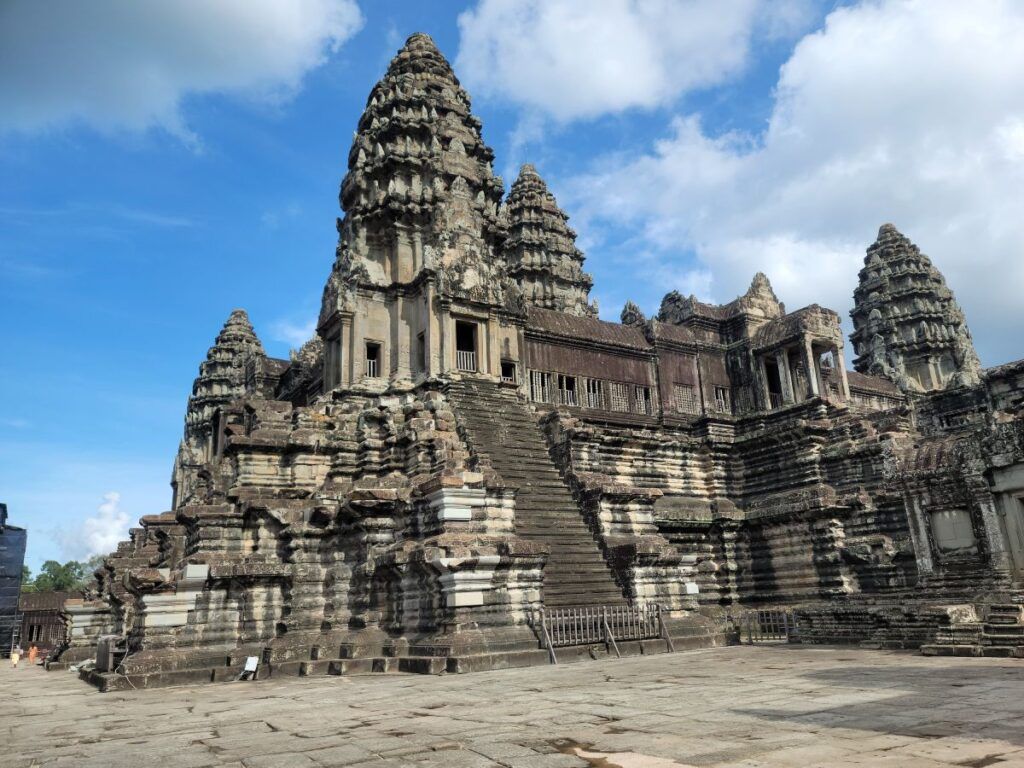
Architecture of Angkor Wat Mandir:
Angkor Wat is a Hindu temple dedicated to the god Vishnu and is known for its intricate and stunning architecture. Here are some key architectural features of Angkor Wat Mandir:
Central Temple Pyramid: Angkor Wat’s most distinctive feature is its central temple pyramid, which is designed to represent Mount Meru, the home of the Hindu gods. The temple has a series of concentric galleries and moats that symbolize the mountain ranges and oceans that encircle Mount Meru.
Moats and Causeways: Cambodia Hindu Temple is surrounded by a large moat and is accessed via a series of causeways. The moat symbolizes the cosmic ocean, and the causeways represent the journey from the mortal world to the divine.
Bakan Sanctuary: At the heart of the temple complex is the Bakan Sanctuary, a tower with a central spire that rises high above the surrounding galleries. This sanctuary is the most sacred part of the temple and was reserved for the king and priests.
Bas-Reliefs: Angkor Wat is renowned for its extensive bas-reliefs, which are intricate and detailed carvings depicting various scenes from Hindu mythology, historical events, and daily life in the Angkorian period. The bas-reliefs can be found on the walls of the galleries and tell stories such as the Churning of the Ocean of Milk and the Ramayana.
Gopurams: This temple has five prominent gopurams (entrance towers) that serve as the main points of entry to the temple complex. Each gopuram is decorated with intricate carvings and sculptures.
Library Buildings: The temple complex includes several library buildings with pyramid-shaped roofs. While these structures may have been used for studying religious texts, they also contribute to the overall architectural symmetry and beauty of Angkor Wat.
Corridors and Galleries: Cambodia Hindu Temple is surrounded by a series of galleries and corridors with intricate sandstone carvings and columns. These areas were used for various purposes, including religious rituals and as a place for pilgrims and visitors to walk and meditate.
Terraces: There are multiple terraces within the temple complex, including the Terrace of Honor, Terrace of the Leper King, and Terrace of the Elephants. These terraces served both practical and ceremonial purposes and are adorned with carvings and sculptures.
Reflecting Pools: Near the central sanctuary, you can find reflecting pools that provide beautiful mirror-like reflections of the temple, particularly during sunrise and sunset.
Spires and Finials: The temple’s towers are crowned with lotus-shaped spires and finials, which add to the overall grandeur of the structure.
Explore More Temples>> Shakti Peethas: The Power of Shakti
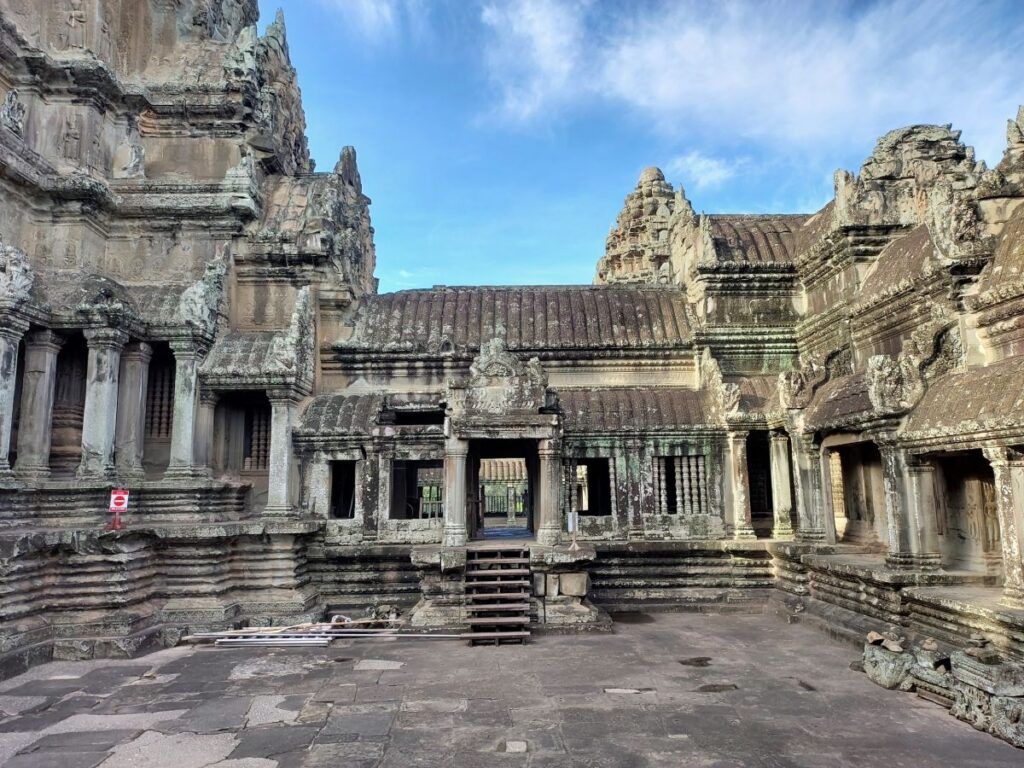
Specialty of Angkor Wat Mandir:
Its size and grandeur: Angkor Wat is the largest religious monument in the world, and its sheer size is awe-inspiring. The temple complex covers an area of 162.6 hectares (402 acres), and its central quincunx of towers rises to a height of 65 meters (213 feet).
Its intricate carvings: Temple is famous for its intricate bas-relief carvings, which depict scenes from Hindu and Buddhist mythology. The carvings are incredibly detailed and well-preserved, and they provide a fascinating glimpse into the religious beliefs and culture of the Khmer people.
Its harmonious proportions: Angkor Wat is admired for the harmony and balance of its design. The temple complex is laid out in a series of concentric squares and rectangles, and the different elements of the temple are perfectly proportioned to each other.
Its spiritual significance: This shrine is a sacred place for both Hindus and Buddhists. It is a place where people come to pray, meditate, and reflect on their spiritual beliefs.
Explore More Temples>> Khajrana Ganesh Temple Indore – Enigmatic 18th Century Idol
Why Angkor Wat was converted into a Buddhist temple:
There are a few reasons why Angkor Wat was converted into a Buddhist temple. First, the Khmer Empire was conquered by the Chams in 1177, and the Chams were Buddhists. Second, the new Khmer king, Jayavarman VII, was married to a Buddhist princess, and he encouraged the conversion to Buddhism. Third, Buddhism was becoming increasingly popular in Southeast Asia at the time, and the Khmer Empire wanted to remain competitive with other Buddhist kingdoms.
As part of the conversion to Buddhism, many of the Hindu sculptures at Angkor Wat were replaced with Buddhist sculptures. For example, the original statue of Vishnu in the central sanctuary was replaced with a statue of Buddha. In addition, many of the reliefs on Cambodia Hindu Temple walls were changed to depict Buddhist stories and symbols.
The conversion of Angkor Wat into a Buddhist temple was a significant event in the history of Cambodia. It marked the end of the Hindu era in Cambodia and the beginning of the Buddhist era. Today, this shrine is one of the most important Buddhist pilgrimage sites in Southeast Asia.
Bhussit site is a Sanskrit term that means “abandoned place.” It is used to describe a Hindu or Buddhist temple that has been abandoned and is no longer in use. There are many bhussit sites in India and Southeast Asia, including some of the most famous temples in the world, such as Angkor Wat.
Angkor Wat is not considered to be a bhussit site in the traditional sense, as it is still in use as a Buddhist temple. However, the term has sometimes been used to describe the temple’s state of disrepair in the centuries since the Khmer Empire collapsed. For example, in the early 19th century, the French explorer Henri Mouhot described Angkor Wat as a “ruinous city” and a “vast monument, half-buried in the ground.”
Explore More Temples>> Kedarnath Temple: Where Faith Meets Jyotirling & Char Dham Yatra

Places to visit near Angkor Wat Mandir:
Angkor Thom: This is a massive walled city and includes some of the most iconic temples in the Angkor complex, such as the Bayon Temple with its stone faces.
Ta Prohm: Known as the “Tomb Raider” temple, Ta Prohm is famous for the way tree roots and jungle vegetation have intertwined with the temple’s structure.
Banteay Srei: This temple, located farther from the main Angkor area, is renowned for its intricate pink sandstone carvings.
Angkor National Museum: This museum is a great place to start your visit to Angkor. It provides valuable historical and cultural context to the temples you’ll explore.
Phnom Bakheng: This hilltop temple offers panoramic views of the Angkor Wat complex, especially during sunset. It’s a popular spot for tourists, so arrive early to secure a good viewing spot.
Tonle Sap Lake: This is the largest freshwater lake in Southeast Asia and is known for its floating villages. You can take boat tours to explore the lake and see the local way of life.
Beng Mealea: This temple is further from the main Angkor area and is known for its jungle-covered ruins, which offer a sense of exploration and adventure.
Preah Khan: This temple, similar in style to Ta Prohm, features intricate carvings and a sense of mystery due to its partly unrestored state.
Bakong: Part of the Roluos Group, Bakong is one of the earliest temple mountains in the region and is known for its unique architecture.
Kbal Spean: This site is famous for its intricately carved riverbed and rock formations, with images of Hindu gods and other religious motifs.
Phnom Kulen: This mountain range has a sacred history and features waterfalls, ancient temples, and the famous “River of a Thousand Lingas.”
War Museum Cambodia: Located in Siem Reap, this museum provides insights into Cambodia’s more recent history, particularly the Khmer Rouge era.
Explore More Temples>> Bhadrachalam Temple | Bhadradri Seetha Ramachandra Swamy
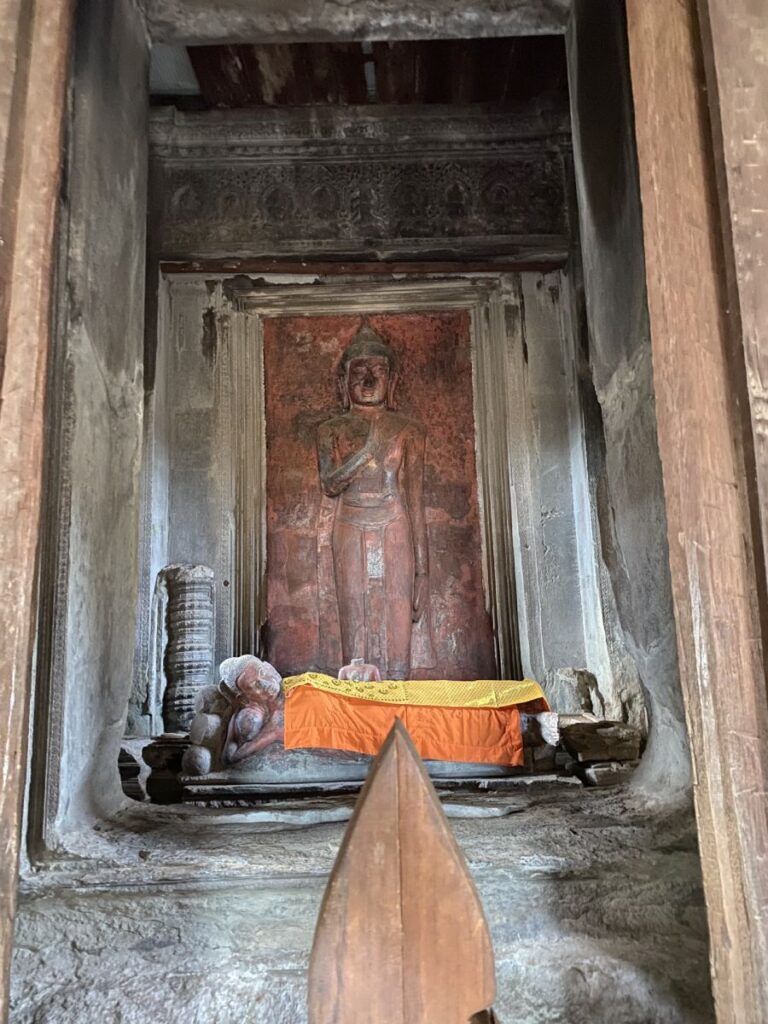
Angkor Wat Temple Construction:
Angkor Wat is a temple complex in Cambodia built by the Khmer King Suryavarman II (reigned 1113–1150) in the first half of the 12th century as a Hindu temple dedicated to the god Vishnu.
The construction of Angkor Wat is a marvel of engineering and architecture. It is estimated that over 300,000 workers and 6,000 elephants were involved in the construction of the temple complex. The temple is made of sandstone blocks, which were quarried and transported from over 20 kilometers away.
One of the most impressive aspects of Angkor Wat is its scale. The temple complex covers an area of over 400 acres (160 hectares) and is surrounded by a moat that is 5 kilometers (3 miles) long. The central temple is over 200 feet (61 meters) tall and has five towers, which represent the five peaks of Mount Meru, the home of the gods in Hindu mythology.
Another impressive aspect of Angkor Wat is its intricate carvings. The temple walls are covered in carvings of Hindu deities, scenes from Hindu mythology, and everyday life in the Khmer Empire. The carvings are incredibly detailed and well-preserved, even after over 900 years.
Angkor Wat was originally a Hindu temple, but it was converted to a Buddhist temple in the 16th century. The temple complex remained in use as a Buddhist temple until the 19th century, when it was abandoned. Angkor Wat was rediscovered by French explorers in the 1860s and has since been restored and preserved.
Explore More Temples>> Sacred 12 Jyotirlingas in India: A Symbol of Eternal Spirit

FAQ:
Q: What is Angkor Wat Mandir?
A: Angkor Wat Mandir, is a Hindu temple complex in Cambodia and the world’s largest religious monument. It was built in the early 12th century by King Suryavarman II as his state temple and eventual mausoleum. The temple is dedicated to the Hindu god Vishnu, and is designed to represent Mount Meru, the home of the devas in Hindu mythology.
Q: Where is Angkor Wat Mandir located?
A: This shrine is located in Siem Reap, Cambodia, about 6 kilometers north of the city center. It is part of the Angkor Archaeological Park, a UNESCO World Heritage Site.
Q: What is the best time to visit Angkor Wat Mandir?
A: The best time to visit Angkor Wat Mandir is during the dry season, from November to April. During this time, the weather is mild and sunny, and the trails are in good condition. However, Angkor Wat is a popular tourist destination throughout the year, so it is important to book your flights and accommodation in advance, especially if you are traveling during peak season.
Q: How do I get to Angkor Wat Mandir?
A: There are a number of ways to get to Angkor Wat Mandir, including by plane, bus, or taxi. The nearest international airport is Siem Reap International Airport (REP), which is located about 7 kilometers from the city center. There are regular flights to REP from major cities in Southeast Asia, such as Bangkok, Ho Chi Minh City, and Kuala Lumpur.
Once you arrive in Siem Reap, you can take a taxi or tuk-tuk to Angkor Wat Mandir. The journey takes about 20 minutes. You can also purchase a one-day, three-day, or seven-day pass to the Angkor Archaeological Park, which includes transportation to and from the temples.
Q: What are the best things to see and do at Angkor Wat Mandir?
A: Angkor Wat Mandir is a vast complex, and there is something for everyone to see and do. Some of the most popular attractions include:
- The main temple of Angkor Wat, with its five iconic towers
- The Bayon Temple, with its many stone faces
- The Baphuon Temple, with its pyramid-shaped structure
- The Ta Prohm Temple, which is known for its trees growing out of the ruins
- The Preah Khan Temple, which is a large complex with many different buildings
In addition to visiting the temples, you can also take a boat trip on Tonle Sap Lake, visit the Angkor National Museum, or learn about Khmer culture at the Cambodian Cultural Village.
Q: What are some tips for visiting Angkor Wat Mandir?
- Dress respectfully, as Angkor Wat Mandir is still a religious site. This means covering your shoulders and knees.
- Wear comfortable shoes, as you will be doing a lot of walking.
- Bring sunscreen, a hat, and water, especially if you are visiting during the dry season.
- Be aware of your surroundings and take care of your belongings. Angkor Wat Mandir is a popular tourist destination, and there have been reports of thefts.
Explore More Temples>> Tirumala Tirupati Venkateswara Swamy
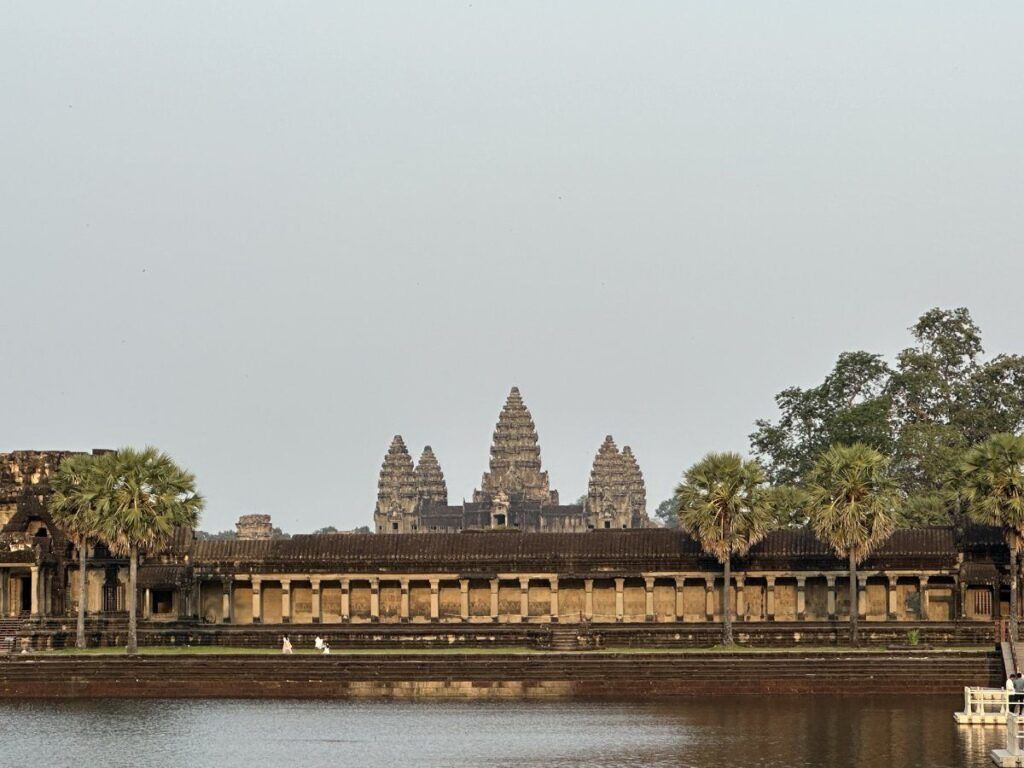
How to reach Angkor Wat Mandir:
- International Travel: If you are traveling from outside of Cambodia, you’ll need to book a flight to Siem Reap International Airport (IATA code: REP). There are direct flights from several major cities in Asia, including Bangkok, Singapore, Kuala Lumpur, and Ho Chi Minh City.
- Visa: Ensure you have the necessary visa to enter Cambodia. Many nationalities can obtain a visa on arrival, while others may need to apply for a visa in advance. Check the Cambodian embassy or consulate in your home country for the most up-to-date visa requirements.
- Arrival in Siem Reap: Upon arrival at Siem Reap International Airport, you will go through immigration and customs. Once you’ve cleared these processes, you are in Siem Reap.
- Transport to Angkor Wat: Angkor Wat is located approximately 6 kilometers (about 3.7 miles) north of Siem Reap city center. You have several options to get to Angkor Wat from Siem Reap:
- a. Tuk-tuk: Tuk-tuks are a popular and affordable mode of transportation in Siem Reap. You can hire a tuk-tuk driver to take you to Angkor Wat and other temples in the area. Negotiate the price beforehand.
- b. Bicycle: Many travelers rent bicycles to explore the temples in the Angkor Archaeological Park, including Angkor Wat. Just be prepared for the heat and the potential for long distances between temples.
- c. Motorbike or Scooter: You can rent a motorbike or scooter if you’re comfortable with Cambodian traffic. Ensure you have the necessary licenses and take safety precautions.
- d. Taxi: You can also hire a taxi to take you to Angkor Wat. This is a more comfortable but pricier option compared to tuk-tuks.
- Entrance Tickets: Before entering Angkor Wat, you need to purchase an admission pass, which can be obtained at the Angkor Archaeological Park ticket booth. There are one-day, three-day, and seven-day passes available.
- Exploring Angkor Wat: Once you’ve arrived at Angkor Wat, you can explore the temple complex at your own pace. It’s advisable to have a map or guidebook to help you navigate the vast site.
